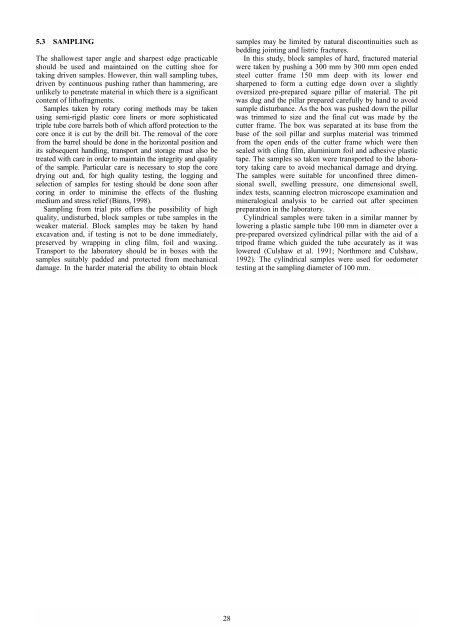Engineering geology of British rocks and soils Mudstones of the ...
Engineering geology of British rocks and soils Mudstones of the ...
Engineering geology of British rocks and soils Mudstones of the ...
Create successful ePaper yourself
Turn your PDF publications into a flip-book with our unique Google optimized e-Paper software.
5.3 SAMPLING<br />
The shallowest taper angle <strong>and</strong> sharpest edge practicable<br />
should be used <strong>and</strong> maintained on <strong>the</strong> cutting shoe for<br />
taking driven samples. However, thin wall sampling tubes,<br />
driven by continuous pushing ra<strong>the</strong>r than hammering, are<br />
unlikely to penetrate material in which <strong>the</strong>re is a significant<br />
content <strong>of</strong> lith<strong>of</strong>ragments.<br />
Samples taken by rotary coring methods may be taken<br />
using semi-rigid plastic core liners or more sophisticated<br />
triple tube core barrels both <strong>of</strong> which afford protection to <strong>the</strong><br />
core once it is cut by <strong>the</strong> drill bit. The removal <strong>of</strong> <strong>the</strong> core<br />
from <strong>the</strong> barrel should be done in <strong>the</strong> horizontal position <strong>and</strong><br />
its subsequent h<strong>and</strong>ling, transport <strong>and</strong> storage must also be<br />
treated with care in order to maintain <strong>the</strong> integrity <strong>and</strong> quality<br />
<strong>of</strong> <strong>the</strong> sample. Particular care is necessary to stop <strong>the</strong> core<br />
drying out <strong>and</strong>, for high quality testing, <strong>the</strong> logging <strong>and</strong><br />
selection <strong>of</strong> samples for testing should be done soon after<br />
coring in order to minimise <strong>the</strong> effects <strong>of</strong> <strong>the</strong> flushing<br />
medium <strong>and</strong> stress relief (Binns, 1998).<br />
Sampling from trial pits <strong>of</strong>fers <strong>the</strong> possibility <strong>of</strong> high<br />
quality, undisturbed, block samples or tube samples in <strong>the</strong><br />
weaker material. Block samples may be taken by h<strong>and</strong><br />
excavation <strong>and</strong>, if testing is not to be done immediately,<br />
preserved by wrapping in cling film, foil <strong>and</strong> waxing.<br />
Transport to <strong>the</strong> laboratory should be in boxes with <strong>the</strong><br />
samples suitably padded <strong>and</strong> protected from mechanical<br />
damage. In <strong>the</strong> harder material <strong>the</strong> ability to obtain block<br />
28<br />
samples may be limited by natural discontinuities such as<br />
bedding jointing <strong>and</strong> listric fractures.<br />
In this study, block samples <strong>of</strong> hard, fractured material<br />
were taken by pushing a 300 mm by 300 mm open ended<br />
steel cutter frame 150 mm deep with its lower end<br />
sharpened to form a cutting edge down over a slightly<br />
oversized pre-prepared square pillar <strong>of</strong> material. The pit<br />
was dug <strong>and</strong> <strong>the</strong> pillar prepared carefully by h<strong>and</strong> to avoid<br />
sample disturbance. As <strong>the</strong> box was pushed down <strong>the</strong> pillar<br />
was trimmed to size <strong>and</strong> <strong>the</strong> final cut was made by <strong>the</strong><br />
cutter frame. The box was separated at its base from <strong>the</strong><br />
base <strong>of</strong> <strong>the</strong> soil pillar <strong>and</strong> surplus material was trimmed<br />
from <strong>the</strong> open ends <strong>of</strong> <strong>the</strong> cutter frame which were <strong>the</strong>n<br />
sealed with cling film, aluminium foil <strong>and</strong> adhesive plastic<br />
tape. The samples so taken were transported to <strong>the</strong> laboratory<br />
taking care to avoid mechanical damage <strong>and</strong> drying.<br />
The samples were suitable for unconfined three dimensional<br />
swell, swelling pressure, one dimensional swell,<br />
index tests, scanning electron microscope examination <strong>and</strong><br />
mineralogical analysis to be carried out after specimen<br />
preparation in <strong>the</strong> laboratory.<br />
Cylindrical samples were taken in a similar manner by<br />
lowering a plastic sample tube 100 mm in diameter over a<br />
pre-prepared oversized cylindrical pillar with <strong>the</strong> aid <strong>of</strong> a<br />
tripod frame which guided <strong>the</strong> tube accurately as it was<br />
lowered (Culshaw et al. 1991; Northmore <strong>and</strong> Culshaw,<br />
1992). The cylindrical samples were used for oedometer<br />
testing at <strong>the</strong> sampling diameter <strong>of</strong> 100 mm.

















